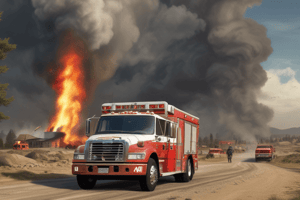Podcast
Questions and Answers
What does 10-1 indicate?
What does 10-1 indicate?
- Receiving good
- OK or acknowledged
- Receiving poorly (correct)
- Relay information
What does 10-2 mean?
What does 10-2 mean?
- Receiving good (correct)
- Receiving poorly
- Location
- Station unmanned
What does 10-4 signify?
What does 10-4 signify?
- OK or acknowledged (correct)
- Busy, standby
- Out of service
- Please call by phone
10-5 is used to relay what?
10-5 is used to relay what?
What does 10-7 mean?
What does 10-7 mean?
10-10 indicates what?
10-10 indicates what?
What is the meaning of 10-13?
What is the meaning of 10-13?
What does 10-28 refer to?
What does 10-28 refer to?
What does 10-41 mean?
What does 10-41 mean?
What is the meaning of 10-50?
What is the meaning of 10-50?
10-19 means ___ to Station.
10-19 means ___ to Station.
What does 10-49 refer to?
What does 10-49 refer to?
10-32 means what?
10-32 means what?
What does 10-26 signify?
What does 10-26 signify?
Match the following 10 codes with their meanings:
Match the following 10 codes with their meanings:
Flashcards are hidden until you start studying
Study Notes
EMS 10 Codes Overview
- 10-1: Indicates poor reception of the communication.
- 10-2: Signifies good reception of the communication.
- 10-4: Acknowledgment or confirmation that a message was received.
- 10-5: Used to relay information to another unit.
- 10-6: Denotes that the unit is busy and requests standby.
- 10-7: Means the unit is out of service or dead on arrival (DOA).
- 10-8: Indicates the unit is back in its service area.
- 10-9: A request to repeat the last transmission.
- 10-10: Indicates the unit is back in service.
Emergency Situations and Requests
- 10-13: Alerts that police assistance is needed.
- 10-14: Simply means out of service.
- 10-15: Indicates the station is unmanned.
- 10-16: Signals that the unit is en route to the hospital.
- 10-17: Indicates the unit is en route to a specified location.
- 10-19: Means returning to the station.
Communication and Location Codes
- 10-20: Refers to the location of the unit or incident.
- 10-21: Requests a phone call for further communication.
- 10-22: Instructs to disregard or cancel the previous order.
- 10-23: Signals to switch to Channel 2 for communication.
- 10-24: Requests the dispatch of rescue units.
Units and Resources Management
- 10-25: Indicates mechanical problems with the unit.
- 10-26: Requests additional units for assistance.
- 10-27: Calls for fire units to be sent.
- 10-31: Notes that a unit is en route to a specific hospital.
Communication Channels
- 10-32: Requests to go to Channel 2.
- 10-33: Requests to switch to Channel 3.
- 10-34: Requests to switch to Channel 4.
Patient and Incident Management
- 10-38: Indicates the unit has arrived at the station.
- 10-40: Refers to a person being dead on arrival (DOA).
- 10-41: Signifies a heart attack event.
- 10-42: Refers to a mental health patient.
- 10-43: Indicates a case of poisoning or overdose.
- 10-45: Highlights a vehicle accident.
- 10-46: Refers to an emergency patient transfer.
- 10-47: Signifies a routine patient transfer.
- 10-48: Indicates a case of overdose.
- 10-49: Refers to a suicide attempt.
- 10-50: Indicates a working fire and requests fire dispatch.
Scene and Response Codes
- 10-90: Signifies that the unit has arrived on the scene.
- 10-87: Asks for confirmation of communication capabilities.
Studying That Suits You
Use AI to generate personalized quizzes and flashcards to suit your learning preferences.




